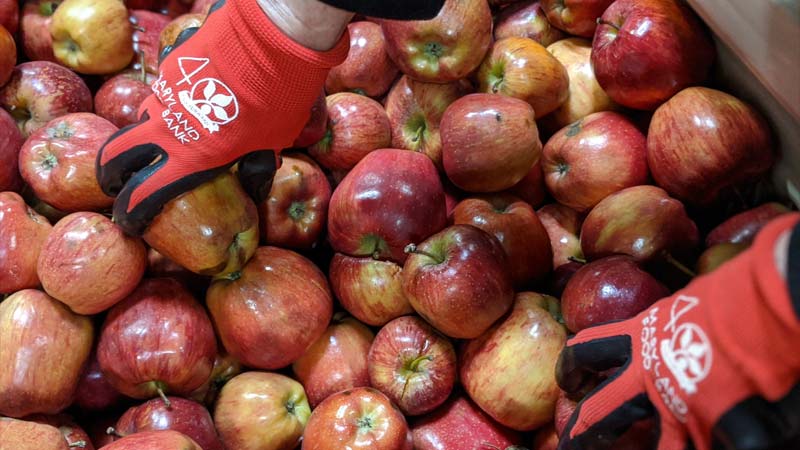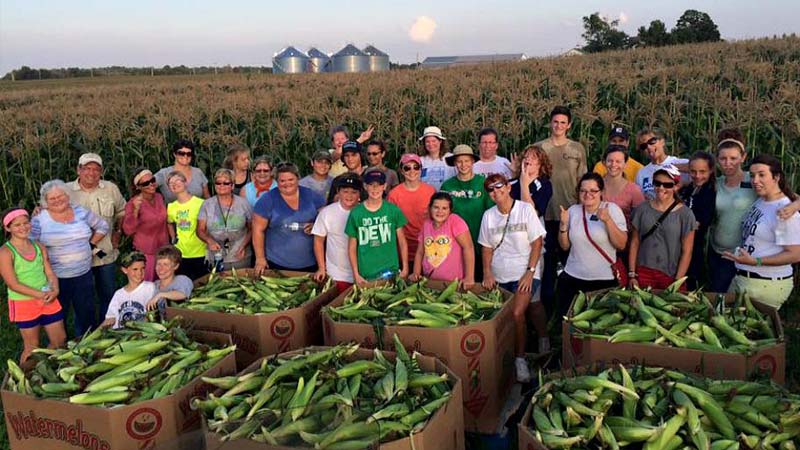Helping Improve Marylanders’ Nutrition Today and Tomorrow

In the second of our three-part series of posts on nutrition, we highlighted some of the ways we were able to keep a strong focus on nutrition, despite the barriers COVID-19 placed in our way. Now, we’d like to share how we’re continuing to innovate, and find new ways to help Marylanders improve their health through better nutrition.
As we approach summer 2021, MFB’s overarching focus remains on providing food access to our neighbors in need, many of whom are suffering from the long-term financial and emotional effects of the pandemic.
But we are using new data, new resources, and new tools to be even more intentional about the nutritional quality of that food – from the types of food we source to how we distribute it, and most importantly, how these conscious actions will improve the lives of food-insecure Marylanders.
“The Maryland Food Bank is the only organization in the state with the experience, expertise, and the reach to help lift up all of Maryland though improved nutrition,” said MFB Executive Vice President & Chief Strategy Officer Meg Kimmel. “With more partnerships, more programs, and more data to help guide our decision making, we’re leading the charge for a better, healthier Maryland.”
Good Nutrition In, Good Nutrition Out
As noted in the first blog in this series, Better Nutrition for a Healthier Maryland, we were only able to provide access to whatever foods were donated to us or what we rescued from local retailers in the early days of the food bank. In almost a complete reversal, 2020 saw us purchasing higher volumes of food than at any other time in our 42-year history.
“In hindsight, being forced into a primarily purchased food model turned out to be a benefit for us and our neighbors in need,” said Nekeisia Booyer, MFB’s Senior Vice President of Programs. “It gives us more control over the types of food in our system, and by continuing to aggressively purchase nutritious food, MFB will be able to consistently ensure healthy options are distributed equitably across the state.”
And while we believe this to be the shortest path to helping Marylanders become healthier, it is also the most costly. In fact, between March 2020 and April 2021, we spent $33 million on food, a 438 percent increase over the same time period before COVID.

Thinking Inside the Box
Uncontrollable circumstances should not dictate whether a family can eat a healthy meal. That’s why, since COVID first emerged, MFB has worked to bring nutritious foods directly into the hands and homes of those who need it most. Early in the pandemic, we refreshed the “old-school” idea of pre-boxed food and created Back Up Boxes (BUBs) as a contactless way to provide a week’s worth of food (30 pounds) to those struggling during the crisis. And after transitioning to a healthier version of the generic box , we’re ready to take BUBs to the next level.
By distributing BUBs and encouraging the MFB partner network to accompany these boxes with fresh produce, the Maryland Food Bank is one step closer to transforming the benefits of healthy food into a universal right, no matter a person’s identity or circumstances.
“With our knowledge of the differing needs among communities, new data, and the offsite facility we created to help us meet the need during the pandemic, we have the resources to be more deliberate about the foods we are providing to specific communities to address specific needs,” said Kate Long, MFB’s Director of Nutrition Programs.

Our latest BUBs are versioned boxes that contain healthy foods and nutrition education materials appropriate for Latin communities, older adults, and people with diabetes, respectively:
- MFB recognizes that Communities of Color have been disproportionally affected by the wide-ranging effects of food insecurity. By offering items such as beans, Maseca flour, chicken, oat milk, and more, we can help individuals of Latin descent ensure they’re receiving high-quality foods that help improve their nutrition.
- Older adults, who often face a combination of medical and geographic barriers to good nutrition, will have access to smaller, lighter, 15-pound BUBs, filled with healthy, shelf-stable foods to make the task of preparing wholesome meals of high nutritional quality a simpler one.
- For our neighbors in need afflicted with Type 2 diabetes (which historically includes a disproportionate representation for Communities of Color), these BUBs will include food with minimal to no added sugars.
In addition to food, recipes and nutrition education flyers will continue to be included to help hungry Marylanders maximize the impact of BUBs on their well-being.
Outstanding in the Field
Since 2010, MFB’s Farm to Food Bank Program has partnered with farms and orchards statewide to provide fresh fruits and vegetables to those lacking access to healthy, affordable foods. With support from the state’s Department of Human Services, the program has sourced and distributed more than 32 million pounds of locally grown produce since its inception, and this year marks 10 growing seasons of making fresh foods accessible for families who might otherwise go without.
Funded through the annual State of Maryland Governor’s grant, these larger-scale farms have done an excellent job in providing fresh and healthy foods to our neighbors in need; but what if we could do more by transporting less?

“Since its inception in 2010, I can’t think of another program that has had as significant an effect on the well-being of our state than Farm to Food Bank,” Booyer noted. “And by expanding into alternative forms of growing food, such as community gardens, our neighbors in need will have increased access to the healthy foods they need to thrive.”
Recently, the Maryland Food Bank has been exploring ways to source foods from urban farms to help uplift communities and establish sustainable solutions to hunger. Partnering with urban farms and more community gardens in areas across the state will allow MFB to ensure locally grown fruits and vegetables can remain in those communities, providing residents with access to nutritious, quality food on a regular basis.
Health Clinics & Nutrition
In 2019, we teamed up with the Harriet Lane Clinic at Johns Hopkins Children’s Center to set up Maryland’s first food pantry in a hospital setting. And when the pandemic broke, the pantry took on a whole new level of importance to the community.
“When this started, our phone volume from patients was almost five times the normal rate, and much of it was about food. So they really thought ‘this clinic is a place that is going to be able to help me with this,’ and when we’re able to say at that moment, ‘you know what, we actually have a food pantry,’ you could just hear the relief in their voices,” said Kristin Topel, Program Manager, Hopkins Community Connection.
Throughout 2021 and beyond, we’re seeking to expand partnerships with healthcare organizations to provide wrap-around services to those in need. By introducing new partnerships and expanding existing collaborations with organizations like the Harriet Lane Clinic, Shepherd’s Clinic, and the MedStar Good Samaritan Hospital, MFB is going beyond food distribution events to create hospital-based food pantries and provide resources that help low-income, food-insecure individuals meet their most basic needs.
Ending the Cycle
In a recent report on the health implications of hunger, Feeding America provided a stark description of “The Cycle of Hunger and Health”:
“First, a food-insecure household is forced to engage in coping strategies, often including the consumption of cheaper foods that are high in calories but low in nutritional value. Reliance on less healthy foods can lead to toxic stress, poor nutrition, and chronic diet-related diseases such as diabetes and obesity. In turn, these chronic illnesses can worsen existing disabilities or other illnesses or result in an inability to work and increased healthcare costs, which further restrict the household food budget. Once a person or family enters the cycle, it can be increasingly difficult to escape it.”
While this cycle may be difficult to escape, we believe our increased focus on nutrition — starting with the types of food we purchase, to how we make it available to our partners, and ultimately helping our neighbors in need use it — can help more Marylanders break free from this cycle.
From the child who needs high-quality, nutritious food to fuel their academic success to the older adult who wants to live their golden years to the fullest, and anyone in between, we can build a stronger Maryland by improving the nutrition of the people who live here.
Get updates on our progress in the fight against hunger
Want to see how your involvement directly impacts the well-being of your neighbors in need? Get the latest news sent to your inbox.







